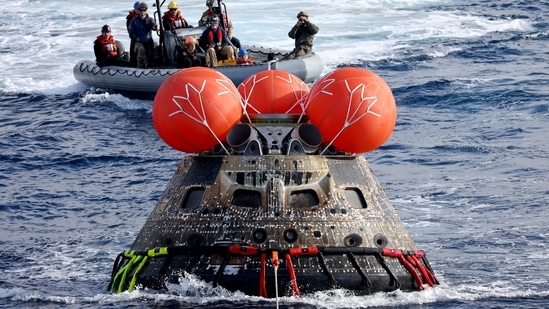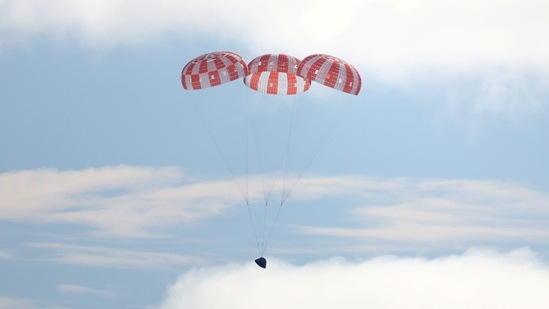Photos: A look at Orion, NASA’s new moon mission, and the first since Apollo 17
Published on Dec 12, 2022 06:28 PM IST
Orion has become the first capsule to visit the moon since Apollo 17 in December 1972, launching on NASA's new mega moon rocket from the Kennedy Space Center on November 16. It was the first flight of NASA's new Artemis moon program, named after Apollo's mythological twin sister. On December 11, NASA's Orion capsule made a blisteringly return from the moon, parachuting into the Pacific off Mexico to conclude a test flight that should clear the way for astronauts on the next lunar flyby.
1 / 9

Published on Dec 12, 2022 06:28 PM IST
NASA's Orion capsule is drawn to the well deck of the U.S.S. Portland after it splashed down following a successful uncrewed Artemis I Moon Mission on December 11 in the Pacific Ocean off the coast of Baja California, Mexico. (Mario Tama / REUTERS)
2 / 9

Published on Dec 12, 2022 06:28 PM IST
Video feeds displayed after NASA's Orion capsule was brought into the well deck of the U.S.S. Portland following a successful uncrewed Artemis I Moon Mission, seen from aboard the Portland on December 11. The incoming capsule hit the atmosphere at Mach 32, or 32 times the speed of sound, and endured reentry temperatures of 5,000 degrees Fahrenheit (2,760 degrees Celsius) before splashing down west of Baja California near Guadalupe Island, AP reported.(Mario Tama / REUTERS)
3 / 9

Published on Dec 12, 2022 06:28 PM IST
An Air Force member releases a weather balloon off the deck of the U.S.S. Portland (LPD 27) as part of the recovery operation for the Orion capsule off the coast of Baja California, Mexico, on December 11. A Navy ship quickly moved in to recover the spacecraft and its silent occupants — three test dummies rigged with vibration sensors and radiation monitors.(Caroline Brehman / REUTERS)
4 / 9

Published on Dec 12, 2022 06:28 PM IST
NASA's Orion Capsule descends toward splash down after a successful uncrewed Artemis I Moon Mission on December 11.(Mario Tama / REUTERS)
5 / 9

Published on Dec 12, 2022 06:28 PM IST
Video screens in the USS Portland command center show live feeds of the recovery operations as NASA's Orion Capsule splashes in the Pacific Ocean off the coast of Baja California, Mexico, on December 11. “I'm overwhelmed,” NASA Administrator Bill Nelson told AP from Mission Control in Houston. “This is an extraordinary day ... It's historic because we are now going back into space — deep space — with a new generation.” (Mario Tama / AFP)
6 / 9

Published on Dec 12, 2022 06:28 PM IST
A Sasquatch Team member watches as NASA's Orion capsule makes its way towards the U.S.S. Portland (LPD 27) after being successfully secured by a NASA and US Navy team, off the coast of Baja California, Mexico, on December 11. With a return speed of 25,000 mph (40,000 kph) — considerably faster than coming in from low-Earth orbit — the capsule used a new, advanced heat shield never tested before in spaceflight.(Caroline Brehman / REUTERS)
7 / 9

Published on Dec 12, 2022 06:28 PM IST
A view of the Orion spacecraft is seen approaching earth on December 11. At its farthest, the capsule was more than 268,000 miles (430,000 kilometers) from earth. Orion beamed back stunning photos of not only the gray, pitted moon, but also the home planet.(NASA / AP)
8 / 9

Published on Dec 12, 2022 06:28 PM IST
HSC-23 Navy flight crew members watch as NASA's Orion capsule floats in the well deck after being successfully secured by a NASA and US Navy team, off the coast of Baja California, Mexico, on December 11. (Caroline Brehman / REUTERS)
9 / 9

Published on Dec 12, 2022 06:28 PM IST





